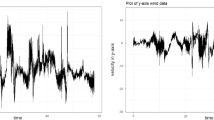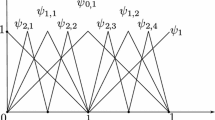Abstract
This paper establishes the global asymptotic equivalence, in the sense of the Le Cam \(\Delta \)-distance, between scalar diffusion models with unknown drift function and small variance on the one side, and nonparametric autoregressive models on the other side. The time horizon \(T\) is kept fixed and both the cases of discrete and continuous observation of the path are treated. We allow non constant diffusion coefficient, bounded but possibly tending to zero. The asymptotic equivalences are established by constructing explicit equivalence mappings.
Similar content being viewed by others
References
Brown LD, Low MG (1996) Asymptotic equivalene of nonparametri regressionand white noise. Ann Stat 24(6):2384–2398
Brown LD, Zhang C-H (1998) Asymptotic nonequivalene of nonparametri experiments when the smoothness index is 1/2. Ann Stat 26(1):279–287
Brown LD et al (2002) Asymptotic equivalene theory for nonparametri regression with random design. Ann Stat 30:688–707
Brown LD et al (2004) Equivalene theory for density estimation, Poisson processes and Gaussian white noise with drift. Ann Stat 32(5):2074–2097
Buhmann B, Müller G (2012) Limit experiments of GARCH. Bernoulli 18(1):64–99
Carter AV (2006) A continuous Gaussian approximation to a nonparametri regres-sion in two dimensions. Bernoulli 12(1):143–156
Carter AV (2007) Asymptotic approximation of nonparametric regression experiments with unknown varianes. Ann Stat 35(4):1644–1673
Carter AV ‘(2009) Asymptotially sufficient statistis in nonparametric regression ex-periments with correlated noise. J Probab Stat , 19, Article ID 275308
Carter AV (2002) Deficiency distance between multinomial and multivariate normal experiments. Ann Stat 30:708–730 Dediated to the memory of Luien Le Cam
Comte F, Genon-Catalot V, Rozenhol Y (2007) Penalized non parametri mean square estimation of the coefficients of diffusion proesses. Bernoulli 13:514–543
Dalalyan A, Reiß M (2007) Asymptotic statistical equivalene for ergodic diffusions: the multi dimension analse. Probab Theory Relat Fields 137(1–2):25–47
Dalalyan A, Reiß M (2006) Asymptotic statistical equivalence for salar ergodic diffusions. Probab Theory Relat Fields 134(2):248–282
Delattre S, Hoffmann M (2002) Asymptoti equivalene for a null reurrent diffusion. Bernoulli 8(2):139–174
Efromovich S, Samarov A (1996) Asymptotic equivalene of non parametric regression and white noise model has its limits. Stat Probab Lett 28(2):143–145
Freidlin MI, Wentzell AD (2012) Random perturbations of dynami al systems. Grundlehren der Mathematishen Wissenshaften [FundamentalPriniples of Mathemati al Sienes. Translated from the 1979 Russian originalby Joseph Szücs. 3rd edn., Springer, Heidelberg, vol 260. pp xxviii+458
Genon-Catalot V (1990) Maximum contrast estimation for diffusion processes from discrete observations. Statistics 21(1):99–116
Genon-Catalot V, Laredo C (2014) Asymptotic equivalence of nonparametric diffusion and Euler scheme experiments. Ann Stat 42(3):1145–1165
Genon-Catalot V, Laredo C, Nussbaum M (2002) Asymptotic equivalence of estimating a Poisson intensity and a positive diffusion drift. Ann Stat 30:731–753 Dedi ated to the memory of Lu ien Le Cam
Golubev GK, Nussbaum M, Zhou HH (2010) Asymptotic equivalence of spectral density estimation and Gaussian white noise. Ann Stat 38(1):181–214
Grama I, Neumann MH (2006) Asymptotic equivalence of nonparametric autoregression and nonparametri regression. Ann Stat 34(4):1701–1732
Grama I, Nussbaum M (1998) Asymptotic equivalence for nonparametric generalized linear models. Probab Theory Relat Fields 111(2):167–214
Grama I, Nussbaum M (2002) Asymptotic equivalence for nonparametric regression. Math Methods Stat 11(1):1–36
Guy R (2013) Inférence dans le cadre des maladies transmissibles par des processus de diffusion. Ph.D thesis
Hoffmann M (1999) Adaptive estimation in diffusion processes. Stoh Process Appl 79(1):135–163
Jacod J, Shiryaev AN (1987) Limit theorems for stochasti processes, vol 288. Springer, Berlin
Jähnisch M, Nussbaum M (2003) Asymptotic equivalence for a model of independent non identically distributed observations. Stat Decis 21(3):197–218
Karatzas I, Shreve SE (2000) Brownian motion and stochastic calculus, 2nd edn., Graduate texts in mathematicsSpringer, New York
Kutoyants YA (1984) On nonparametric estimation of trend coefficients in a diffusion process. Stat Control Stoch Process 230:250
Kutoyants YA (1984) Parameter estimation for stochastic processes, vol 6. Heldermann, Berlin
Laredo C (1990) A sufficient condition for asymptotic sufficiency of incomplete observations of a diffusion process. Ann Stat 18(3):1158–1171
Le Cam L (1986) Asymptotic methods in statistical decision theory., Springer series in statisticsSpringer, New York
Le Cam L, Yang GL (2000) Asymptotics in statistics, 2nd edn., Springer series in statistics. Some basic conceptsSpringer, New York, p xiv+285
Mariucci E (2014) Asymptotic equivalence for inhomogeneous jump diffusion processes and white noise. arXiv: 1405.0480
Meister A (2011) Asymptotic equivalence of functional linear regression and a white noise inverse problem. Ann Stat 39(3):1471–1495
Meister A, Reiß M (2013) Asymptotic equivalence for nonparametric regression with non-regular errors. Probab Theory Relat Fields 155(1–2):201–229
Milstein G, Nussbaum M (1998) Diffusion approximation for nonparametric autoregression. Probab Theory Relat Fields 112(4):535–543
Nussbaum M (1996) Asymptotic equivalence of density estimation and Gaussian white noise. Ann Stat 24(6):2399–2430
Øksendal B (1985) Stochastic differential equations., Universitext. An introduction with applicationsSpringer, Berlin
Picard J (1991) Efficiency of the extended Kalman filter for nonlinear systems with small noise. SIAM J Appl Math 51(3):843–885
Picard J (1986) Nonlinear filtering of one-dimensional diffusions in the case of a high signal-to-noise ratio. SIAM J Appl Math 46(6):1098–1125
Reiß M (2011) Asymptotic equivalence for inference on the volatility from noisy observations. Ann Stat 39(2):772–802
Reiß M (2008) Asymptotic equivalence for nonparametric regression with multivariate and random design. Ann Stat 36(4):1957–1982
Rohde A (2004) On the asymptotic equivalence and rate of convergence of nonparametric regression and Gaussian white noise. Stat Decis 22(3):235–243
Uchida M, Yoshida N (2004) Asymptotic expansion for small diffusions applied to option pricing. Stat Inference Stoch Process 7(3):189–223
Volkonskii V (1958) Random substitution of time in strong Markov processes. Theory Probab Appl 3(3):310–326
Wang Y (2002) Asymptotic nonequivalence of Garch models and diffusions. Ann Stat 30:754–783
Acknowledgments
I would like to thank Valentine Genon-Catalot for several interesting discussions, especially in suggesting to taking into account the relation between diffusion processes with small variance and deterministic limits. Also, I would like to give a special thank to Pierre Étoré, with whom a lot of hours were spent discussing different approaches to the proof of Lemma 4.10. More generally, I am very grateful for all the time he has invested in supervising this project.
Author information
Authors and Affiliations
Corresponding author
Appendix: Background on Le Cam’s theory
Appendix: Background on Le Cam’s theory
1.1 Asymptotic equivalence in the sense of Le Cam
A statistical model is a triplet \(\fancyscript{P}_j=(\fancyscript{X}_j,\fancyscript{A}_j,\{P_{j,\theta }; \theta \in \Theta \})\) where \(\{P_{j,\theta }; \theta \in \Theta \}\) is a family of probability distributions all defined on the same \(\sigma \)-field \(\fancyscript{A}_j\) over the sample space \(\fancyscript{X}_j\) and \(\Theta \) is the parameter space. The deficiency \(\delta (\fancyscript{P}_1,\fancyscript{P}_2)\) of \(\fancyscript{P}_1\) with respect to \(\fancyscript{P}_2\) quantifies “how much information we lose” by using \(\fancyscript{P}_1\) instead of \(\fancyscript{P}_2\) and is defined as \(\delta (\fancyscript{P}_1,\fancyscript{P}_2)=\inf _K\sup _{\theta \in \Theta }||KP_{1,\theta }-P_{2,\theta }||_{TV},\) where TV stands for “total variation” and the infimum is taken over all “transitions” \(K\) (see Le Cam (1986), page 18). In our setting, however, the general notion of “transitions” can be replaced with the notion of Markov kernels. Indeed, when the model \(\fancyscript{P}_1\) is dominated and the sample space \((\fancyscript{X}_2,\fancyscript{A}_2)\) of the experiment \(\fancyscript{P}_2\) is a Polish space, the infimum appearing on the definition of the deficiency \(\delta \) can be taken over all Markov kernels \(K\) on \(\fancyscript{X}_1\times \fancyscript{A}_2\) (see Nussbaum (1996), Proposition 10.2), i.e.
The experiment \(KP_{1,\theta }=(\fancyscript{X}_1,\fancyscript{A}_1,\{KP_{1,\theta }\}_{\theta \in \Theta })\) is called a randomization of \(\fancyscript{P}_1\) by the kernel \(K\). If the kernel is deterministic, i.e. for \(T:(\fancyscript{X}_1,\fancyscript{A}_1)\rightarrow (\fancyscript{X}_2,\fancyscript{A}_2)\) a random variable,  , the experiment \(T\fancyscript{P}_1\) is called the image experiment by the random variable
\(T\). Closely associated with the notion of deficiency is the so called \(\Delta \)-distance, i.e. the pseudo metric defined by:
, the experiment \(T\fancyscript{P}_1\) is called the image experiment by the random variable
\(T\). Closely associated with the notion of deficiency is the so called \(\Delta \)-distance, i.e. the pseudo metric defined by:
The sufficiency of a statistic can be expressed in terms of the \(\Delta \)-distance. More precisely, the following holds (see Genon-Catalot and Laredo (2014), Proposition 8.1, page 23). Let \(T:(\fancyscript{X}_1,\fancyscript{A}_1)\rightarrow (\fancyscript{X}_2,\fancyscript{A}_2)\) be a random variable. The statistic \(T\) is sufficient for \(\fancyscript{P}_1\) if and only if \(\Delta (\fancyscript{P}_1,T\fancyscript{P}_1)=0.\)
Also, remark that thanks to (18), if \(\fancyscript{P}_1=(\fancyscript{X},\fancyscript{A}_1,\{P_\theta ;\theta \in \Theta \})\) and \(\fancyscript{P}_2=(\fancyscript{X},\fancyscript{A}_2,\{P_\theta ;\theta \in \Theta \})\) with \(\fancyscript{A}_2\subset \fancyscript{A}_1\), then \(\delta (\fancyscript{P}_1,\fancyscript{P}_2)=0\).
Two sequences of statistical models \((\fancyscript{P}_{1}^n)_{n\in \mathbb {N}}\) and \((\fancyscript{P}_{2}^n)_{n\in \mathbb {N}}\) are called asymptotically equivalent if \(\Delta (\fancyscript{P}_{1}^n,\fancyscript{P}_{2}^n)\) tends to zero as \(n\) goes to infinity. Similarly, the statistic \(T^n\) is asymptotically sufficient for \(\fancyscript{P}_1^n\) if \(\Delta (\fancyscript{P}_{1}^n,T^n\fancyscript{P}_{1}^n)\) tends to zero as \(n\) goes to infinity.
Rights and permissions
About this article
Cite this article
Mariucci, E. Asymptotic equivalence of discretely observed diffusion processes and their Euler scheme: small variance case. Stat Inference Stoch Process 19, 71–91 (2016). https://doi.org/10.1007/s11203-015-9117-x
Received:
Accepted:
Published:
Issue Date:
DOI: https://doi.org/10.1007/s11203-015-9117-x




